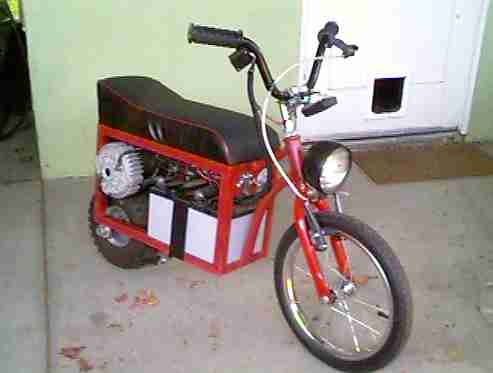
Updated: 01/01/01

The scooter was my first EV and was done to get some experience.
The design for the scooter was more like the mini-bike that I owned when I was a boy. I got some contactors from a friend and bought some wheels from Harbor Freight that were made for a wheelbarrow or wagon. The sprockets and other various drive components were ordered from a go-cart mail order catalog. The seat was plywood upholstered with a bath towel. The underside of the seat served as a mount for the controller components.
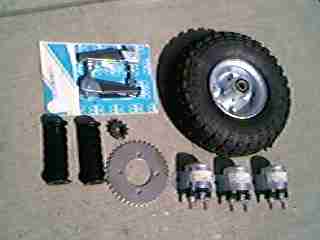
The scooter had to be small and light enough for a child to handle. I knew that 7 and 10 year olds would want to try it. I decided on two U-1 size Concorde AGM batteries. They are sealed and weigh only 23 lbs. each.
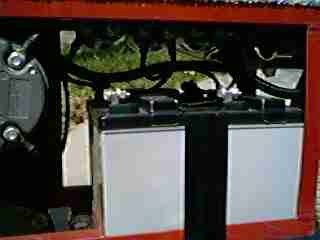
The first motor was rated at 1200 rpm at 12 volts without load. I estimated that it would turn up to 2400 rpm at 24 volts under a small load. The controller is a series/parallel arrangement using 3 SPST contactors. The throttle is a power antenna switch that I had, similar to a power window switch. Rocking it down was low (12 volts) and up was high (24 volts). The center switch position is off.
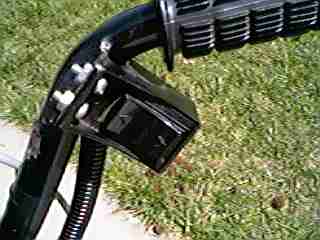
The sprockets were sized for about 20 mph. 60 teeth in the rear and 14 teeth in the front. I scrounged various spacers and other items.
The frame was mostly 1"x1"x.083" CRS box tubing. I finished the frame and had started on the forks when I saw a small girl's bike at a garage sale for $5. I cut the bike in half and welded the front end of it to the scooter frame. I added a BMX brake, which eventually proved inadequate so it was switched for some new mountain bike brakes.
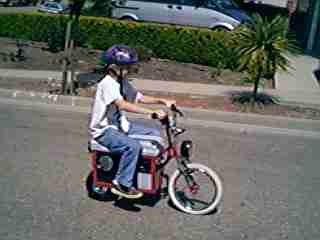
The finished scooter weighed 96 lbs. and originally went about 15 mph. I experimented with gearing and eventually settled on 16 mph using a 40t and 11t sprocket. The original 60t was too close to the ground and would hit if the tire went flat. I tried a higher gearing for 20 mph but climbing was poor and the motor ran too hot. I have driven over 15 miles and still had charge left. It will climb mile long hills that require great effort and stamina on a bicycle. A side benefit of the series/parallel controller and PM motor is great regenerative braking down hill and slowing down. I use high to regen at speeds over 17 mph and low to get regen between 8 and 17 mph.
I eventually switched to a Scott motor. It now has more power and does 25 mph.
The scooter is licensed as a moped or motorized bicycle and only required a one time $5.00 fee payment to make it street legal. I am wiring a headlight, taillight, stoplight and horn for safety.
So I learned a lot and was ready to proceed with my Manx but I got side tracked by some C-cars.
| Design Pacifica |